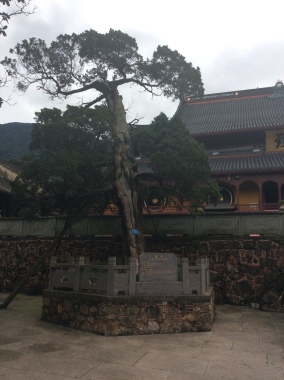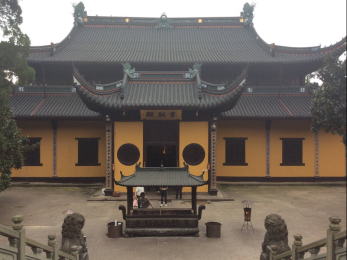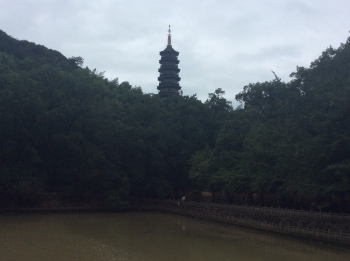Our trip to Tiantong Temple began at Ningbo Bus Terminal. As usual we had the name of the temple written on a scrap of paper in Chinese characters, because the chances of a Chinese taxi driver having any English were next to zero. I showed the driver at the taxi rank the name, he nodded his agreement and we climbed into the taxi. Hence began our ill-planned excursion out to Tiantong Temple, known as one of three historical temples situated in the hills around Ningbo. I didn’t realize just how far it was out to Tiantong until we had driven for about ten minutes through Ningbo and saw a sign saying that Tiantong Temple was a further 25 kilometres away. At this point we worried about how much the taxi fare would come to but decided we were too far into the journey to change plans by that point. I assured Cameron that it wouldn’t come to much more than 100 yuan and that we would catch the bus back into town to avoid further wastefulness.
As it turned out, the trip out to Tiantong was quite pleasant. The road took us through undulating terrain with a number of villages scattered along the roadsides. Compared to most parts of the Yangtze Delta region, it was sparsely populated and there was still quite a lot of forest cover on the hillsides. As in many parts of Northern Zhejiang, it was more a land of tall hills than true mountains but even the forested hills made for a welcome change of scenery coming from Shanghai. At one point the driver took a sudden detour from the main road, which took us onto a winding, back road which seemed to add several kilometres to the journey. But with only a few words of Chinese between us, we didn’t know how to protest, and our suspicions against the driver remained unproven. By the time we finally reached Tiantong Temple, the taxi had reached 96 yuan; I pulled out one of the pink 100 yuan notes and told him, or rather gestured to him, to keep the change.
The temple is set at the base of Mount Taibai, one of the five holy mountains of the Chan sect of Buddhism (a sect known in Japan as Zen). The mountain is thickly cloaked in forest, with tall groves of bamboo on some of the hillsides. There had been a huge downpour the night before as a typhoon had been landfall somewhere in Southern China, so the whole area looked wet and lush. With population pressures relentless in Eastern China, not many temples there had retained their “forest retreat” atmosphere, but it was immediately obvious that Tiantong Temple would be an exception. But before we reached the mountain itself, we had to walk through a bizarre tourist complex that had been built in front of the gate.
As any veteran China traveller will tell you, the country is very big on “development” of tourist sites. No tourist site has really made it unless there is a whole complex of shops and restaurants built to service tour groups. Tiantong Temple was fronted by a large complex of multi-storey buildings, but not one of them had been rented out. The whole complex was an abandoned “ghost mall”, already looking tired and dilapidated a few years after opening. As elsewhere in Asia, projects in China often seem to be financed with little forethought about their viability. Having not attracted a single customer, this project must have been a costly failure, and yet there were similar dubious developments mushrooming in every corner of the country.
When we got to the main gate, we received a pleasant surprise; entrance to the temple was not free. We later learned that the ticket price had been 50 yuan as late as 2012, but they had decided to drop it in response to a high volume of complaints from pilgrims. With our free tickets in hand, we entered the site and were soon walking along the so-called Buddhist Pilgrims’ Road, which led uphill through three ancient gates to the temple proper. A golf-buggy service was available for this part, but we felt that a few hundred metres of walking in the fresh, cool air would add to the experience. At one part, there was an impressive stand of bamboo to our left, and the forested slopes of Mount Taibai had a dark, rich look. Cameron commented that the location of the place might prove to be its main asset, and that proved to be an accurate impression.
Apart from the old gateways, the first of the antiquities is a massive human-made pond called the Wungang Pond, which dated back to the Tang Dynasty. Building this enormous resevoir must have been a colossal undertaking in the 8th century, emphasising the importance of this seemingly isolated place thirteen centuries before. According to legend, the temple had been founded around the year 300 by a monk called Yixing; it was then little more than a simple thatched building on the mountainside. By the Tang Dynasty it had grown into a renowned centre of Budhdist learning, with a prominet temple and a sizable number of monastic buildings. It had later evolved into a centre for the Chan sect of Buddhism, and in the thirteenth century Dogen Zenji, a Japanese monk studied here before returning to Japan and founded a number of early Zen Buddhist temples. For an isolated temple, it had had quite a large influence in the Buddhist world.
From the pond, we set off to look at the temple proper, which consisted of two large halls built in Ming Dynasty style. The first of them was fronted by a stone platform with a couple of stately pine trees planted on other side of the main staircase. Known as the Heavenly King Hall, it had tumeric-yellow walls and a sloping roof of black tiles. The roofline was crowned by some interesting ornamentation, including a sea-green monster and a flaming, golden disc, and a couple of obligatory red lanterns hung down over the main doorway. According to a sign at the front of the temple, the building was a copy of a Ming Dynasty orginal which had been burnt to the ground by bandits in 1933 and rebuilt in 1936. The inside of the temple was marked by huge timber columns and colossal statues, with the dim lighting creating a suitably mystical atmosphere.
Heading out the back door, we came to the lovely, stone-paved courtyard between the who main halls. This was charaterised by two Chinese cypresses, their gnarled trunks giving away their great age; these two trees (one of them now on quite a lean) were four-hundred and fifty years old, meaning they had outlived untold numbers of halls and monastic buildings at Tiantong Temple. In addition, there were a couple of towering incense burners in the courtyard as well as trays for burning candles. The whole area was filled with the heady scent of burning sandalwood, making this perhaps the most appealing parts of the temple.
Upon one more terrace is the second major hall at Tiantong Temple, the Buddha Hall. This building dates back to 1853 but is said to be a faithful copy of an older Ming Dynasty too. It has a more rustic look than the main hall, which may be why it is the more often photographed of the pair. Its chief charm is its long, wooden porch along the front of the temple. Adorned with delicate fretwork and a series of scalloped arches, this porch gives the hall a charmingly “time old” look. Apart from this, it features a heavy, black roof which curls up at the corners. The interior of the temple is characterised by a row of large gilded Buddhas, which had attracted a small group of devotees when we poked our heads inside.
While Tiantong Temple will never be regarded one of China’s leading attractions, it is certainly one of the more interesting historic temples in Zhejiang. Most of its historic architecture has fallen victim to the ravages of time, but the remaining two halls and its mountain location make it an evocative site. Having viewed the main structures, we wandered back down the pilgrims’ road to the main road. We were in luck. We had barely been waiting there for five minutes when a 162 bus came around the bend and stopped for us. The 30 kilometre trip back into town cost a mere 3 yuan. Public transport is definitely a viable option for those traveling out here on a limited budget.


